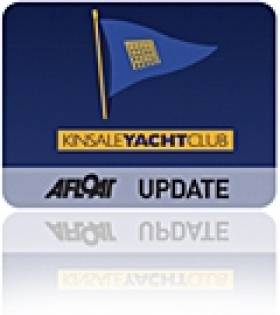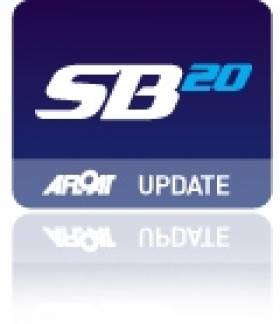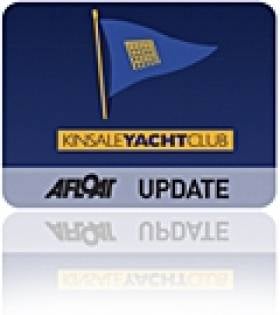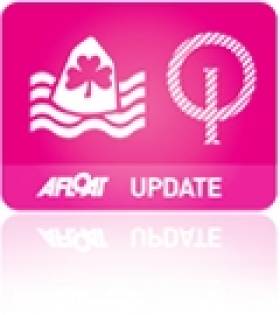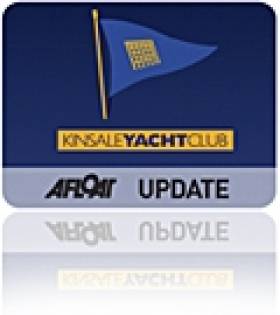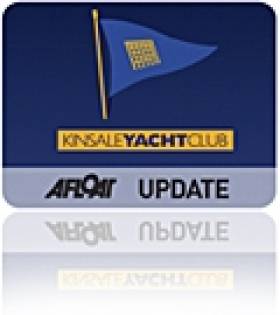Displaying items by tag: Kinsale YC
UK Sailmakers’ Barry Hayes In Howth Next Thursday For First In New Series On Top Tips For Sailors
Barry Hayes from UK Sailmakers Ireland begins a new series of talks with Top Tips For Sailors next Thursday 16 January at Howth Yacht Club from 7.30pm.
Members and guests alike are welcome to attend the two-part session which will cover both optimisation for racing or cruising vessels, and learning how to service your deck hardware — overalls recommended.
Barry will also visit the Royal St George on Thursday 30 January (time TBC) and Kinsale Yacht Club on Thursday 13 February at 7.30pm.

#RB&I - The Royal Western Yacht Club of England is now taking entries for the latest Round Britain and Ireland two-handed race, which starts from Plymouth on Sunday 3 June.
This year marks the 14th running of the quadrennial yacht race, which was established in 1966 by the Cockershell hero Major Blondie Hasler.
The race comprises five legs totalling around 2,000 miles, sailed clockwise around the British Isles and Ireland leaving all islands and rocks to starboard.
The race is open to professional and amateur yachtsmen in mono and multi-hulls from 28ft to 55ft overall.
The Round Britain and Ireland race is essentially five races in one with the results decided on accumulated time (IRC corrected). The legs are relatively short stages of three or four days where time spent at the helm and minimum sleep has to be balanced with the need for solo watch keeping and precise navigation.
The race record stands at 15 days, 7 hours but sailors should allow about 23 days to complete the event, including the four 48-hour stopovers in Kinsale, Castle Bay, Lerwick and Lowestoft.
The first leg from Plymouth to Kinsale is 230 miles long, passing outside the Eddystone and Bishop Rock lights to finish at Bulman Rock. Kinsale Yacht Club is at the head of the accessible and safe harbour.
After the 48-hour stopover, competitors set sail on the second leg from Kinsale for Castle Bay on the island of Barra in the Outer Hebrides. The boats keep the Fastnet Rock to starboard at the beginning of the 440-mile second leg past the South and West coasts of Ireland. On arrival, the fleet moors or anchors in Castle Bay.
Leg three covers a distance of 420 miles. The yachts round Barra Head and sail north northwest 70 miles out into the Atlantic, aiming for the isolated volcanic archipelago of St Kilda, after which the competitors round Muckle Flugga and head to Lerwick, 61 degrees north latitude, on the island of Shetland. The Lerwick Boating Club is the host for two days of jollity and warm hospitality.
The longest leg four is 470 miles south from Lerwick to Lowestoft, which is the most easterly point of the British Isles. The Royal Norfolk and Suffolk Yacht Club provides a very hospitable stopover. Family and friends find this port the most convenient to visit being the most accessible by land.
The final leg five of 305 miles is along the South Coast to Plymouth. This leg often proves to be where the podium places are decided due to the many tidal gates. The finish line is in Plymouth Sound off the RWYC Club House.
The Notice of Race and Entry Form can be found at the RWYC website. For further details, contact the race director David Searle at [email protected] or the RWYC secretariat at [email protected].
As reported earlier today on Afloat.ie, entries are also open for the Volvo Round Ireland Yacht Race 2018, marking the 40th year of the biennial race run by Wicklow Sailing Club.
Meanwhile, the RORC has posted its Pre Notice of Race for the Sevenstar Round Britain and Ireland Race run from Cowes on Sunday 12 August. The previous edition in 2014 was won by Irish duo Liam Coyne and Brian Flahive and their First 36.7 Lula Belle.
Kinsale Yacht Club Open the Door on New Clubhouse Just in Time for the Sovereign's Cup
Kinsale Yacht Club officially opened its club house just in time to host the Sovereign's Cup for cruiser classes and 1720s next week (27th-30th June).
The south coast club will also stage the International Federation of Disabled Sailing World Championships from (22nd-30th August)
Kinsale Yacht Club celebrated the official re-opening of its renovated Clubhouse at a reception for members and guests last night.
Afloat.ie reported on it previously when the SB20 fleet paid their first visit to the new look KYC a fortnight ago.
The 14-week construction programme included the gutting and total re-build of all changing facilities on the ground floor, to include a new Reception/Office, first-class men and women's changing facilities, laundry, cadet training room and gym. All mechanical and electrical services within the building were replaced and the Bar/Dining areas have been totally refurbished. Also, the extended balcony offers a magnificent view over the marina and has total wheelchair access with a new lift to the main entrance area.
KYC Commodore Cameron Good acknowledged the excellent work of MMB Construction, Kiernan Electrical, Simon Walker Architect, JLS Design, Fiona O'Keefe Interiors, Ray Keane & Associates and Martin O'Callaghan Quantity Surveyors.
He thanked members and staff of Kinsale Yacht Club for their patience and support during the transition and highlighted the key role of member David Ross who volunteered many months of his time to manage the project so professionally.
"We are delighted with our new Clubhouse and hope that members will use and enjoy our excellent new facilities" said Good.
#kinsale – The newly revamped Kinsale Yacht Club welcomes the SB20 fleet this coming weekend for their first ever championship event at the South Coast harbour. The new clubhouse opened its doors on the June bank holiday weekend but the SB20 fleet is the first championship event to be hosted there.
PRO Tony Ireson and his team are expecting up to 25 entries for the event and competition is expected to be tight as ever. 6 boats from around Cork Harbour have been doing a lot of local one-design racing and as ever the Cork crews are expected to offer some stiff competition. 5 boats are travelling from the combined Northern Ireland clubs. Past winners Peter Kennedy and Stephen Kane on Ridgefence are good in the light airs and will be ones to watch. Darren Martin from Strangford Lough is proving to be a force to be reckoned and with his light crew could do very well. Defending champion Ben Duncan and his team on Sharkbait will have their work cut out for them especially as conditions are forecast to be light.
For the first time at their regional events, this year the Irish SB20 class are rigidly enforcing the 270 Kilo weight restriction so it will be interesting to see how many of the crews will be stripping down to their underwear at registration. In international fleets, the SB20's are sailed to within a half kilogram of the weight restriction. Some of the top European crews opt for 4 crew members however the Irish crews tend to forfeit weight for added downwind advantage. This weekend will tell which theory is right. The world championships are due to take place in Hyeres in September where weight may be an advantage. Up to 10 Irish boats are expected to make the journey.
Ministerial Approval for Kinsale's Sovereign's Cup
#sovereigns cup – Over a quarter of entries to date for the Sovereign's Cup Regatta hail from the UK and current entry levels are running at over twice the rate of April 2011.
Minister Simon Coveney was in the newly re-opened Acton's Hotel in Kinsale to launch the biennial Sovereign's Cup Regatta last Thursday which is expected to bring 140 boats together with 800 sailors from Ireland and overseas from the 26th to the 29th of June.
Coveney praised the community spirit as Kinsale Yacht Club works with local businesses to ensure that the hundreds of sailors enjoy their week's sailing both on the water and ashore in the gourmet capital of Ireland. The regatta is expected to generate over €600,000 for the tourist town and Kinsale Food Circle restaurants will be utilising the influx of visitors to showcase the best of local produce as they prepare to feed the armada of visiting sailors.
"We are delighted with the financial support provided by our title sponsors, independent investment managers, Covestone Asset Management. The early financial assistance helped in funding our new interactive website which has been instrumental in attracting the large number of early entries. It is clear that skippers begun their planning early for their summer sailing and that Kinsale features high on the list of 'must do' events" commented Mike Walsh, Regatta Director.
As well as the excellent sailing conditions, race management and social programme ashore, sailors and their families are expected to take full advantage of the many famous restaurants that form the Kinsale Good Food Circle. The regatta committee are encouraging people to start thinking about their travel and accommodation plans and are delighted that their new website provides direct links to accommodation and restaurants in Kinsale and that Irish Ferries Ltd are providing discounted rates to those travelling from the UK.
The Sovereign's Cup was established in 1995 and this year marks the 10th staging of this hugely popular cruiser regatta. The biennial event is expected to attract over 140 boats from all over Ireland and the UK to compete for the prestigious Sovereign's Cup for best all round score in IRC and The Portcullis Trophy for best score under progressive handicap.
Entries are being taken in Class 0, 1, 2, 3, 4 and three White Sails classes. This year the Quarter Ton Class Championships and the European 1720 Championship will be taking place during the Sovereign's Cup, bringing many new visitors to Kinsale from Scotland, Wales and the south of England.
Kinsale Yacht Club Announce New Prize for 2013 Sovereign's Cup
#sovereignscup – A novel new prize will be presented at June's Sovereign's Cup. "The Triple Crown" Trophy will be awarded to the boat with the lowest aggregate score under IRC after competing in the Dun Laoghaire to Dingle Race, The ICRA Nationals and Sovereign's Cup. Speaking at the opening reception, Regatta Director Mike Walsh expressed his view that "recognising the efforts of the boats and crews who compete in each of these three events is important" and he hopes it will spark some interest among visiting and South Coast boats alike.
Details of the milestone 10th edition of Sovereign's Cup were announced at a reception at Kinsale Yacht Club, hosted by Regatta Director, Mike Walsh. The Covestone Sovereign's Cup takes place from 26nd-29th June 2013 in the outer harbour of Kinsale and prides itself in offering excellent sailing conditions, as well as an extensive social programme for all to enjoy ashore.
The Sovereign's Cup was established in 1995 as a biennnial event and has been a very successful and hugely popular cruiser regatta since its inception. Boats from all over Ireland and the UK compete for the prestigious Sovereign's Cup for best performing yacht under IRC and the Portcullis Trophy for best performing yacht under ECHO. Anthony O'Leary in his extensively campaigned and successful Ker 39 'Antix' claimed the 2011 Sovereign's Cup with the 2011 Portcullis Trophy going to KYC's own Dave Scott on his X-362 Sport, 'EOS'. Solent based sailor, Rob Gray captured the Irish Quarter Ton Trophy, sailing 'Aquilla'.
"We have already received a number of queries for the 2013 Sovereign's Cup and there is strong interest from both Wales and the English south coast. We are delighted to announce a new partnership with Covestone Asset Management as this year's event sponsor" said Mike Walsh, Regatta Director. Class divisions for the event are anticipated as being Class 0, 1, 2, 3, 4 IRC and ECHO along with and two White Sails classes and an IRC White Sail Class. The Irish Quarter Ton Class Championships will be taking place during the Covestone Sovereign's Cup and this year the Regatta Director is delighted to welcome the return of the extremely competitive and resurgent 1720 class for their European Championship. It is expected both these latter classes will bring many new visitors to Kinsale from the South of England and Wales in particular.
This year will also see renewed cooperation with Kinsale Chamber of Tourism and Kinsale Good Food Circle who will be hosting a Canapé reception at the formal opening on Tuesday 25th June. "We are encouraging people to start thinking about their travel and accommodation plans, and we are delighted to include specific sections on our web site with information on accommodation in the town and the fantastic amenities available in and around Kinsale for families and friends not going out on the water."
Commenting on exciting developments to the event's new interactive web site, which has just gone live, Mr. Walsh announced that "All entries can now be made online which should greatly simplify and enhance the experience. Thanks to event sponsors Covestone Asset Management we have been able to reduce substantially the entry cost from the 2011 levels for the first 80 entries, and as an added bonus the online booking system allows entrants to avail of the early booking discount and not pay until March 31st 2013."
The Regatta Director expressed his thanks to Kinsale Yacht Club, the Race Management Team and all the volunteers involved with the organisation of the Sovereign's Cup and who work extremely hard to organise an excellent programme both on and off the water.
Mike Walsh welcomed Mr. Donal Roche, Managing Director of Covestone Asset Management who expressed his delight to be associated with such a hugely popular event on the South Coast of Ireland. Mr. Walsh said "Kinsale Yacht Club is delighted to have Covestone as the principal sponsor for the Sovereign's Cup Regatta. He noted that Covestone Asset Management are one of the only truly "Family Offices" in Ireland who have grown and maintained their position as a highly regarded investment manager through their conservative approach" and he "looked forward to working with the Covestone team in the buildup to the regatta."
For more information on the Sovereign's Cup, log on to www.sovereignscup.com or contact Kinsale Yacht Club at +353 (0)21 4773433.
Kinsale Yacht Club Prepares for 200 Optimist Dinghies
#optimist – Kinsale Yacht Club is busily preparing for the first of two major sailing events to be held at the club over the next number of months. The Volvo/Davy Irish Optimist Championships begin next week, while the Brewin Dolphin Dragon Gold Cup follows in September.
Next weeks Optimist Nationals will attract almost 200 sailors aged between 8 and 15, and entries include large teams from the UK and India, and individual entries from France, Hong Kong and the US.. We can expect top class sailing over five days under the guidance of leading Race Officer Alan Crosbie.
The twelve race series begins on Tuesday 31st and runs through to Saturday August 4th. The highly competive fleet will compete for the title of National and Open Champion and the foreign entrants can be expected to be amongst the leading contenders, with Max Clapp from the UK returning to try to add the Senior title to the Junior Open title he won last year. Irish eyes will be on our International squad who will be returning from the European and World Championships. Among these Douglas Elmes and Harry Whitaker from RCYC can be considered serious contenders, while local sailors Scott Levie and Cliodhna Ni Shuilleabhain (returning from a fine 8th place at the French Nationals) won't be far from the leaders.
Whatever happens on the water, these young sailors are sure to bring a lot of excitement and energy to the town over the course of the weeks sailing. The program of events for the week kicks off with an opening ceremony at Charles Fort on Monday 30th July at 7pm.
Kinsale Yacht Club Spring Series Starts Sunday
Kinsale Yacht Club's Spring series kicks off on Sunday and incorporates the first races of the SCORA league. There will be nine races over five weekends with results scored in IRC, IRC Restricted and Echo handicaps. Racing will be either round the cans or on windward-leewards courses. Event Poster downloadable below.
More Difficult Conditions for Kinsale Frostbiters (PHOTOS HERE!)
#KINSALE – Variable light winds were again the dominating feature of the ASM-Marine Frostbite League at Kinsale Yacht club which moved into the fifth and penultimate week of the series last Sunday. Despite the loss of two days racing so far, the Race Committee has successfully managed to keep the programme on course with the addition of extra races when possible.
Competitors were presented with arguably the most difficult set of conditions of the series so far as a NW Force 2 constantly veered and backed in strength and direction throughout the course on each race, finally backing further to the West. As conditions were markedly different at each rounding mark and as the wind pressure shifted unpredictably, positions within each fleet were inevitably on the move too, making for a fascinating series of races which would have an impact on the overall standings for some competitors.

Against this back-drop and with a flooding tide crossing the course, racing got under way on time at 12.00 with a combined start for the Laser 4.7, Radial and Standard Classes.
Outstanding performance of the day goes to Laser Standard sailor James Long (ISKC) who scored four straight wins in all races. Previously in third place on thirteen points behind leader Ronan Kenneally (MBSC), his performance now puts him just six points behind. Ronan, with seven straight wins previously to his credit untypically scored two thirds, a second and an eighth. Robert Howe (MBSC) due to two DNC's recorded as not competing on Sunday, slips to third place overall and may have too much to do to regain second. Edward Rice (RCYC) scored a well-earned two seconds and a fourth.

New entrant Colm O'Regan (KYC) made an immediate and impressive impact in the Radial Class as he followed a second place in the first race with an excellent three straight wins. However, with two discards already applied and a maximum possible third to come on the final day, it appears Colum's effect on the outcome is ultimately limited. The top of the Radial table continues to be a moveable feast as Eoin Cotter (KYC) maintaining his consistent form with a further two fourths and two thirds finds himself up two places and in the lead by ten points overall. Previous leader Seafra Guilfoyle (RCYC) not racing this week drops one place to second overall but remains very much in contention. Darragh O'Sullivan (KYC) though carrying two DNC's from last week returned with a first, two seconds and a fourth which moved him up two places into third overall. Dermot Lyden (RCYC/BSC) recorded an excellent second and two thirds.

Cian Byrne (RCYC) retsins his lead at the top of the Laser 4.7 Class by a comfortable eight points due to two first places in the first and last races, despite scoring a further third and fourth which he can now discard. Still hot on his heels is Kinsale's Ross O'Sullivan who despite a untypical tenth in the third race which he can also discard, with a second, third and fourth is now eight points behind overall. Sorcha Ni Shuilleabhain's (KYC) also retained her overall position of third, but critically moved closer to that second position with an excellent return of a first and two seconds. Cliodhna O'Regan (KYC) with the second best performance in this class, moved closer to the third spot with a first, a second and two thirds just three points adrift overall.
In the face of stiff opposition against improving and determined competition on a day of difficult sailing conditions, James and Bruce Mathews (KYC) in Mucky Duck commendably managed to extend their lead at the top of the Squib fleet. Though changing positions were a feature throughout the day, the Mathew's father and son team came out on top with a first, a second, a first and finally a second. However strong challenges were offered by Marcus and Meagan Hutchinson (KYC) in Sensation during the first two races, and an improving Colm Dunne and Mark Buckley (KYC) in Yacht Services in the last two, both crews recording a win and a second. Despite an OCS in the third race requiring a restart, Sensation came back to score an excellent fourth, but a further fourth in the last race has left them on equal points overall with Yacht Services and ten points behind the leader.
Next Sunday 26th, February sees the completion of this year's ASM Frostbites at KYC.
Kinsale's Frostbite Series in Full Swing (Photos here!)
#KINSALE–Sailing in the annual ASM Marine sponsored Kinsale Yacht Club Frostbite series is underway inside Kinsale Harbour. Brian Carlin captured yestrerday's action (below) in the Squib keelboat and dinghy classes.
The league runs over six Sundays in Late Jaunary and February about sixty sailors will enjoy short sharp races on the Bandon River in underneath Kinsale's famous Charles Fort.
Racing features starts for all singlehanded Laser classes, mixed dinghies and Squibs. Three races are scheduled for each class every weekend. If the full programme is sailed over the six weeks that will see 18 starts for each class.
Entry fees are modest and include mooring and dinghy park space for all competitors.






























